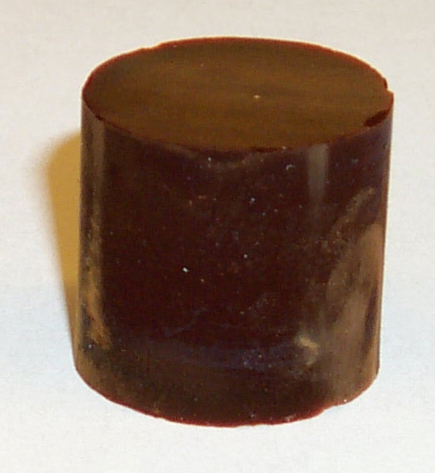Iron Oxide Aerogels
Materials
- Iron nitrate nonahydrate, Fe(NO3)3•9H2O
- Propylene oxide, C3H6O
- Absolute (200-proof) ethanol, C2H5OH
Note: If your propylene oxide comes in a SureSeal® bottle from Aldrich or something like it (has a bottle cap with a diaphragm you have to puncture) you may also need
- Syringe with a Luer lock connection
- Needle with coring (sharp) tip, 18-22 gauge
- Nitrogen gas line with a small needle at the end to backfill bottle
Optional
- Iron chloride hexahydrate, FeCl3•6H2O
- Anhydrous iron chloride, FeCl3
- Epichlorohydrin
- Methanol, CH3OH
- Deionized water
Warning!
Propylene oxide is a known carcinogen (exposure can cause cancer), and epichlorohydrin is probably too. If you plan on doing this procedure, take the proper precautions to prevent your exposure to the vapors of these substances by using a fume hood in lab, if possible, or at the very least a fitted respirator (gas mask) with the right organics cartridges and a well-ventilated space, on top of the usual splash goggles, gloves, long pants, and closed-toe shoes.
Look under Explore > Information About Chemicals to see where you can find health and safety information about these and other chemicals.
If you can’t use these substances safely, don’t use them until you can!
Gel Preparation
- Weigh 0.65 g Fe(NO3)3•9H2O and dissolve in 2.76 g (3.5 mL) of ethanol.
- Weigh 1.00 g (1.20 mL) propylene oxide and add to the beaker slowly (~1-2 mL per minute) with stirring. Note: Addition of the propylene oxide causes the solution to heat up. Introduction of the propylene oxide too quickly can cause it to boil up–add cautiously. Weighing instead of measuring by volume is important. The gel time and gel quality is sensitive to the amount of propylene oxide. The solution will become an intense dark red-brown color.
- A rigid red-brown gel will result. Gel time is about 3 min.
What Doesn’t Work
- Dumping all the propylene oxide in at once. It can cause the solution to get hot very quickly and start to boil.
- Using water as the solvent instead of ethanol. No gel will result.
- Using anhydrous iron
Problems You Might Have
- Overall this procedure is pretty reliable, however your gel times may vary in practice.
Variables You Can Play With
- Try using epichlorohydrin instead of propylene oxide. Epichlorhydrin seems to have a longer shelf-life and might be easier to work with.
- You can adjust the density of the gels by adjusting the amount of solvent.
- Try using isopropanol instead of ethanol (it’s cheaper).
- Try using FeCl3•6H2O instead of Fe(NO3)3•9H2O. You will generally get longer gel times and can use water instead of ethanol as the solvent.
- Try using FeCl3. You will only get gels if you use ethanol as the solvent and add water. This is because the hydrated salts FeCl3•6H2O and Fe(NO3)3•9H2O bring their own water with them in crystalline form. Water is apparently necessary for the chemical reactions to happen.
Gel Processing Conditions
- Once the gel has set, place it under ethanol solution and allow the gel to age for at least 24 h.
- Exchange into 200-proof ethanol at least four times over the course of several days to a week.
- Supercritically dry. A suggested procedure would be to heat the CO2 through its critical point (31.1°C and 72.9 bars) to ~45°C while maintaining a pressure of ~100 bars. Depressurize at a rate of ~7 bar h-1.
What You Should Get
Rigid, monolithic rust-colored red-brown iron oxide aerogel with a stoichiometry approximately Fe2O3.
Using Fe(NO3)3•9H2O as the salt you should get iron oxide aerogels with:
- Density 0.070 g cm-3
- Surface area 340 m2 g-1
- Pore volume 1.25 cm3 g-1
- Average pore diameter 12 nm
Using FeCl3•6H2O as the salt you should get iron oxide aerogels with:
- Density 0.070 g cm-3
- Surface area 390 m2 g-1
- Pore volume 3.75 cm3 g-1
- Average pore diameter 23 nm
The aerogel density can be tailored from 0.070 g cm-3 to 0.2 g cm-3 depending on how concentrated you make the gel solution.
Useful Information
Iron nitrate nona236489hydrate:
- Molecular weight 404.00 g mol-1
- Sigma-Aldrich part number 216828
Iron chloride hexahydrate:
- Molecular weight 207.30 g mol-1
- Sigma-Aldrich part number 237078
Propylene oxide:
- Molecular weight 58.08 g mol-1
- Density 0.83 g mL-1
- Sigma-Aldrich part number 110205 or 82320
Ethanol:
- Molecular weight 46.07 g mol-1
- Density 0.789 g mL-1
- Sigma-Aldrich part number 459836 or 459844, or get Everclear from a liquor store
Epichlorhydrin:
- Molecular weight 92.52 g mol-1
- Density 1.183 g mL-1
- Sigma-Aldrich part number 240699
References
-
Alexander E. Gash, Thomas M. Tillotson, Joe H. Satcher, Jr., John F. Poco, Lawrence W. Hrubesh, Randall L. Simpson, “Use of Epoxides in the Sol-Gel Synthesis of Porous Iron(III) Oxide Monoliths from Fe(III) Salts”, Chemistry of Materials, 2001, 13 (3), 999-1007. DOI: 10.1021/cm0007611
-
Alexander E. Gash, Joe H. Satcher Jr., Randall L. Simpson, “Strong Akaganeite Aerogel Monoliths Using Epoxides: Synthesis and Characterization”, Chemistry of Materials, 2003, 15 (17), 3268-3275. DOI: 10.1021/cm034211p


Thank you for sharing your valuable harvest.
I am going to fabricate a monolithic cobalt ferrite Aerogel using citrate sol-gel procedure which is consist of iron citrate and cobalt nitrate as metal precursors, citric acid and ethylene glycol as co-polymerization agents and distilled water as solvent. The citrate sol-gel route successfully examined and resulted in homogonous and stable gel also pure CoFe2O4 phase after annealing treatment at 600 ͦc.
Would you please guidance me that applying the supercritical drying for my achieved aged gel, according to your write up manner, could be resulted in monolithic cobalt ferrite aerogel?
Thank you for sharing this information! It is very much appreciated!